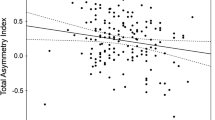Abstract
A new hypothesis is proposed to explain the perennially enlarged breasts of human females. The nubility hypothesis proposes that hominid females evolved protruding breasts because the size and shape of breasts function as an honest signal of residual reproductive value. Hominid females with greater residual reproductive value were preferred by males once reliable cues to ovulation were lost and long-term bonding evolved. This adaptation was favored because female-female competition for investing males increased once hominid males began to provide valuable resources.
Similar content being viewed by others
References
Anderson, J. L. 1988 Breasts, Hips, and Buttocks Revisited. Ethology and Sociobiology 9:319–324.
Boyle, P. 1988 Epidemiology of Breast Cancer. In Bailliere’s Clinical Oncology, U. Veronesi, ed. Pp. 1–57. Eastborne: Bailliere Tindall.
Buss, D. 1994 The Evolution of Desire. New York: Basic Books.
Cant, J. 1981 Hypotheses for the Evolution of Human Breasts and Buttocks. American Naturalist 117:199–204.
Caro, T. M., and D. W. Sellen 1990 The Reproductive Advantages of Fat in Women. Ethology and Sociobiology 11:51–66.
Cohen, M. N. 1980 Speculations on the Evolution of Density Measurement and Population in Homo Sapiens. In Biosocial Mechanisms of Population Regulation, M. N. Cohen, R. S. Malpass, and H. G. Klein, eds. Pp. 275–304. New Haven: Yale University Press.
Daly, M., and M. Wilson 1983 Sex, Evolution and Behavior. Belmont: Wadsworth.
Dawkins, R., and J. R. Krebs 1978 Animal Signals: Information or Manipulation? In Behavioral Ecology: An Evolutionary Approach, J. R. Krebs and N. B. Davies, eds. Pp. 282–309. Oxford: Blackwell Scientific.
Fisher, R. A. 1958 The Genetical Theory of Natural Selection. New York: Dover.
Ford, C. S., and F. A. Beach 1951 Patterns of Sexual Behavior. New York: Harper.
Frisch, R. 1978 Population, Food Intake, and Fertility. Science 199:22–30.
Gallup, G. G. 1982 Permanent Breast Enlargement in Human Females: A Sociobiological Analysis. Journal of Human Evolution 11:597–601.
Goodall, J. 1986 The Chimpanzees of Gombe. Cambridge: Belknap Press of Harvard University.
Huss-Ashmore, R. 1980 Fat and Fertility: Demographic Implications of Differential Fat Storage. Yearbook of Physical Anthropology 23:65–91.
Hytten, F. E., and I. Leitch 1971 The Physiology of Human Pregnancy, second ed. Oxford: Blackwell.
Kaplan, H. 1997 The Evolution of the Human Life Course. In Between Zeus and Salmon: The Biodemography of Longevity, K. Watcher and C. Finch, eds. Pp. 175–211. Washington, D.C.: National Academy of Sciences.
Kendrick, D. T., and R. C. Keefe 1992 Age Preferences in Mates Reflect Differences in Human Reproductive Strategies. Behavioral and Brain Sciences 15:75–133.
Krebs, J. R., and R. Dawkins 1984 Animal Signals: Mind Reading and Manipulation. In Behavioral Ecology: An Evolutionary Approach, second ed., J. R. Krebs and N. B. Davies, eds. Pp. 380–402. Oxford: Blackwell.
Lancaster, J. B. 1986 Human Adolescence and Reproduction: An Evolutionary Perspective. In School-Age Pregnancy and Parenthood: Biosocial Dimensions, J. B. Lancaster and B. A. Hamburg, eds. Pp. 17–37. New York: Aldine de Gruyter.
Low, B. S., R. D. Alexander, and K. M. Noonan 1987 Human Hips, Breasts and Buttocks: Is Fat Deceptive? Ethology and Sociobiology 4:249–257.
1988 Response to Judith Anderson’s Comments on Low, Alexander, and Noonan. Ethology and Sociobiology 9:325–328.
1990 Fat and Deception: Response to Caro and Sellen’s Comments on Low, Alexander, and Noonan. Ethology and Sociobiology 11:67–74.
Manning, J. T., D. Scutt, G. H. Whitehouse, and S. J. Leinster 1997 Breast Asymmetry and Phenotypic Quality in Women. Evolution and Human Behavior 18:223–236.
Mascia-Lees, F. E., J. H. Relethford, and T. Sorger 1986 Evolutionary Perspectives on Permanent Breast Enlargement in Human Females. American Anthropologist 88:423–429.
Masters, W. H., V. E. Johnson, and R. C. Kolodny 1988 Human Sexuality, third ed. Glenview: Scott, Foresman.
McCary, J. L. 1973 Human Sexuality, second ed. New York: D. Van Nostrand.
Møller, A. P., M. Soler, and R. Thornhill 1995 Breast Asymmetry, Sexual Selection, and Human Reproductive Success. Ethology and Sociobiology 16:207–219.
Niefert, M. R., J. M. Seacat, and W. E. Jobe 1985 Lactation Failure Due to Insufficient Glandular Development of the Breast. Pediatrics 76:823–828.
Rebuffe-Scrive, M., E. Lennart, N. Crona, P. Lonnroth, L. Abrahamsson, U. Smith, and P. Bjorntorp 1985 Fat Cell Metabolism in Different Regions in Women. Journal of Clinical Investigation 75:1973–1976.
Short, R. V. 1976 The Evolution of Human Reproduction. Proceedings of the Royal Society B195:3–24.
Singh, D. 1995 Female Health, Attractiveness, and Desirability for Relationships: Role of Breast Asymmetry and Waist-To-Hip Ratio. Ethology and Sociobiology 16:465–481.
Smith, N. W. 1986 Psychology and Evolution of Breasts. Human Evolution 1:285–286.
Smith, R. L. 1984 Human Sperm Competition. In Sperm Competition and the Evolution of Animal Mating Systems, R. L. Smith, ed. Pp. 601–659. New York: Academic.
The Diagram Group 1983 Woman’s Body: An Owner’s Manual. New York: Bantam.
Whiting, J. W., V. K. Burbank, and M. S. Ratner 1986 The Duration of Maidenhood across Cultures. In School-Age Pregnancy and Parenthood: Biosocial Dimensions, J. B. Lancaster and B. A. Hamburg, eds. Pp. 273–302. New York: Aldine de Gruyter.
Author information
Authors and Affiliations
Additional information
Frank Marlowe is research has focused on paternal care and mating effort among Hadza hunter-gatherers. He is also interested in mate preferences, mating systems, and life history theory.
Rights and permissions
About this article
Cite this article
Marlowe, F. The nubility hypothesis. Hum Nat 9, 263–271 (1998). https://doi.org/10.1007/s12110-998-1005-2
Received:
Accepted:
Issue Date:
DOI: https://doi.org/10.1007/s12110-998-1005-2




